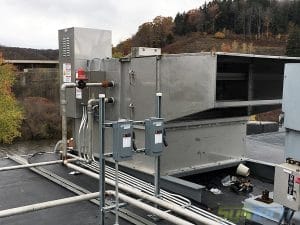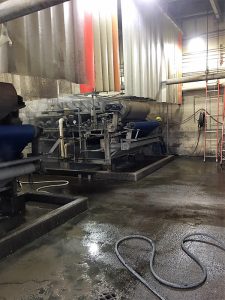Engineered Ventilation Design Results in Improved Indoor Air Quality and Decreased Employee Exposure at Pulp & Paper Mill
SysTech was recently contacted by a pulp and paper mill north of Pittsburgh, Pennsylvania, to address employee exposure to Hydrogen Sulfide (H₂S) from sludge dewatering process. In recent years, The American Conference of Governmental Industrial Hygienists (ACGIH) has changed its recommended threshold limit values (TLVs) for exposure to airborne H₂S. Previously, the exposure limit was a concentration of 10 parts per million (ppm) over an eight-hour shift. The current recommended exposure over an eight-hour shift is one 1 ppm. These exposure limit recommendations are not mandatory; however, they are strongly suggested to prevent long-term health effects that can be caused by over-exposure.
The problem area within the plant was a poorly ventilated sludge press room. Removing the sludge press machines was not an option, as they are a necessary component used to remove water from pulp in various types of paper production. Unfortunately, a byproduct of the sludge press process is the presence of H₂S gas. The current ventilation method consisted of (2) wall mounted, supply air fans that were undersized given the room’s footprint or space envelope and barely functional. The wall mounted units were coupled with (2) exhaust roof ventilators that were no longer in good working order, due to damage caused by the presence of H₂S and other caustic chemicals over time. Heating the space during the winter months was by two small unit heaters suspended from the ceiling. The unit heaters were not effective enough to overcome any of the exhaust fans while in operation, so throughout the heating season, there was almost no ventilation or heating of this space. In addition to not moving a large enough volume of air throughout the space, the airflow pattern itself was incorrectly engineered. H₂S is heavier than air and builds up at floor level. A proper design would feature a high to low airflow pattern, ensuring effective exhaust of the H₂S gas.
SysTech developed an improved ventilation design, based around an aggressive air change-out rate, of 15 air changes per hour. Our design featured (2) roof mounted Weather-Rite TT-218 make-up air units, supplying the room with a total of 16,000 CFM of filtered outside air. The air handlers were designed to be steam powered to provide peak operating efficiency, as steam was readily available as part of the manufacturing process. The make-up air units featured complete 304 SS construction, as well as a protective phenolic coating on the steam coil. This was done to ensure maximum lifespan of the ventilation equipment, as it would constantly be exposed to H₂S and other caustic chemicals. The control set for the air handlers featured both a summer and winter setting allowing the units to be used effectively during the warmer months. SysTech’s design also included (2) 8,000 CFM wall mounted Hartzell Series 02 axial exhaust fans. Hartzell Air Movement was chosen as the fan manufacturer due to their reputation as an industry leader in producing heavy-duty industrial fans. The exhaust fans also featured complete 304 SS construction, along with stainless steel washdown duty motors. Stainless steel was selected to ensure durability and allow for a long lifespan while operating in an environment with elevated levels of H₂S gas. The orientation of the new ventilation equipment ensured a high to low airflow pattern. The supply air units would pressurize the space by discharging fresh air through roof penetrations, and the wall mounted fans were situated low to the ground, to allow for efficient exhausting of H₂S gas and easy wash-down.
After implementing the new ventilation design, the pulp and paper mill has seen a dramatic improvement in the air quality of the sludge press room. Previously, the presence of H₂S was measured as high as 30 ppm concentration. Since the new ventilation system has been in operation, the H₂S levels have been greatly reduced, with spot measurement readings varying between 1-2 ppm. The reduced levels of H₂S have allowed for increased employee exposure to the area without the requirement of a breathing apparatus. In turn, this has enabled the ability to monitor the process firsthand and has allowed for additional maintenance access without the requirement of a shutdown.
Have a corrosive environment that needs ventilation? We’ve had opportunities for successful applications with this problem. We can help improve your air quality. Call us at 800-456-9460.



